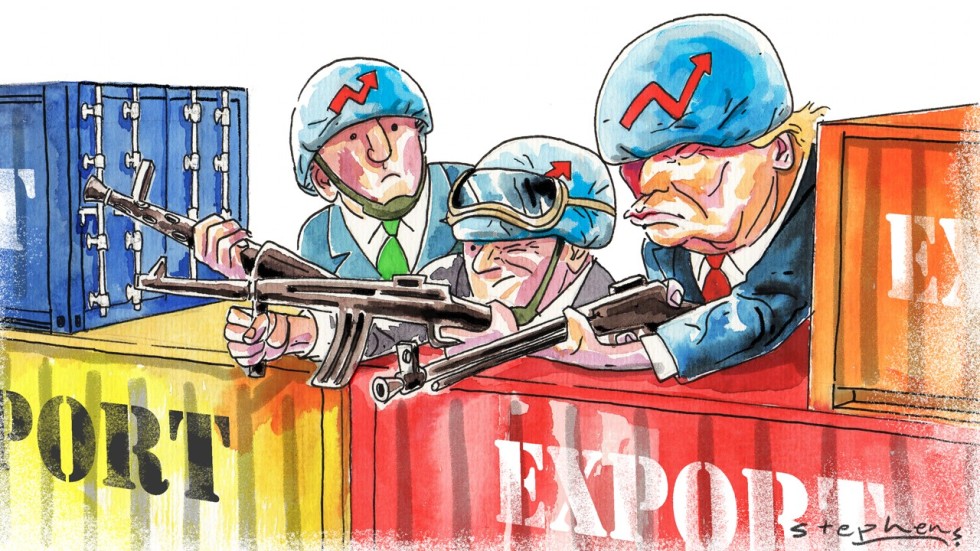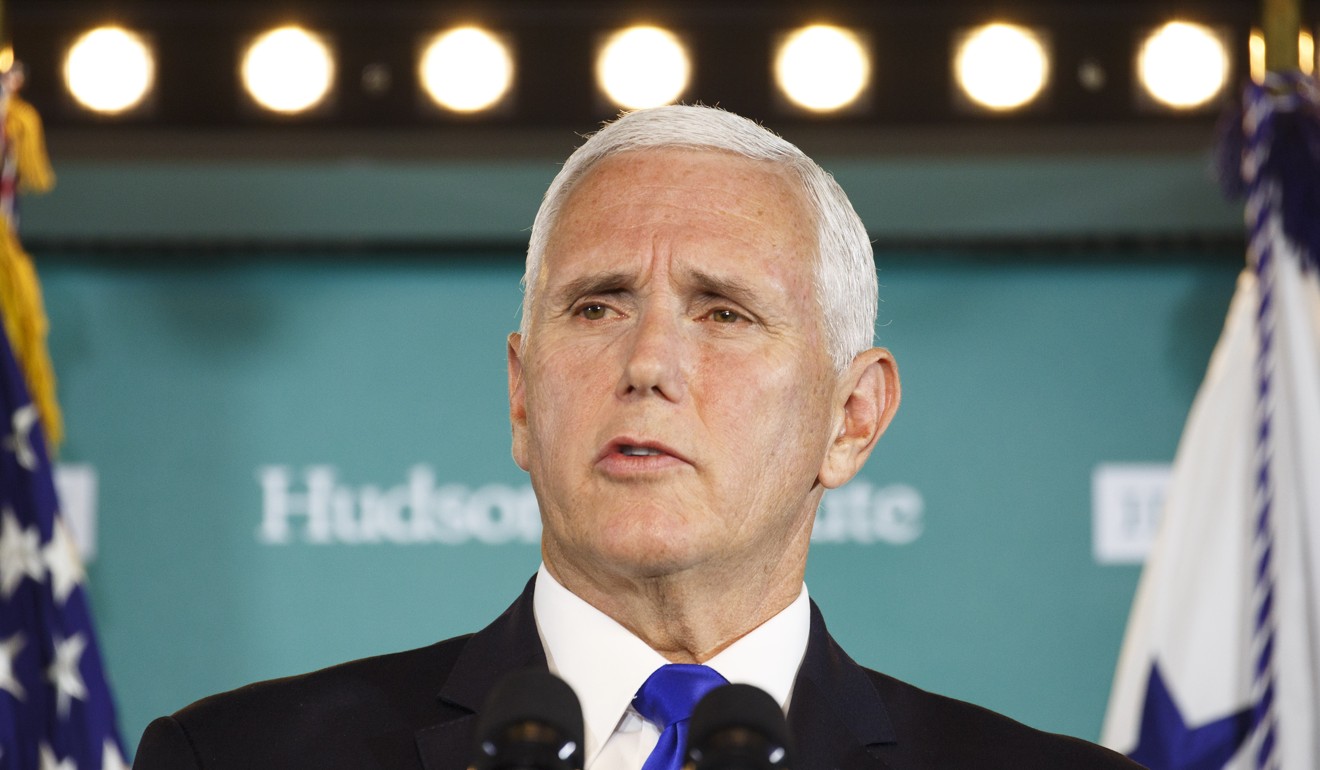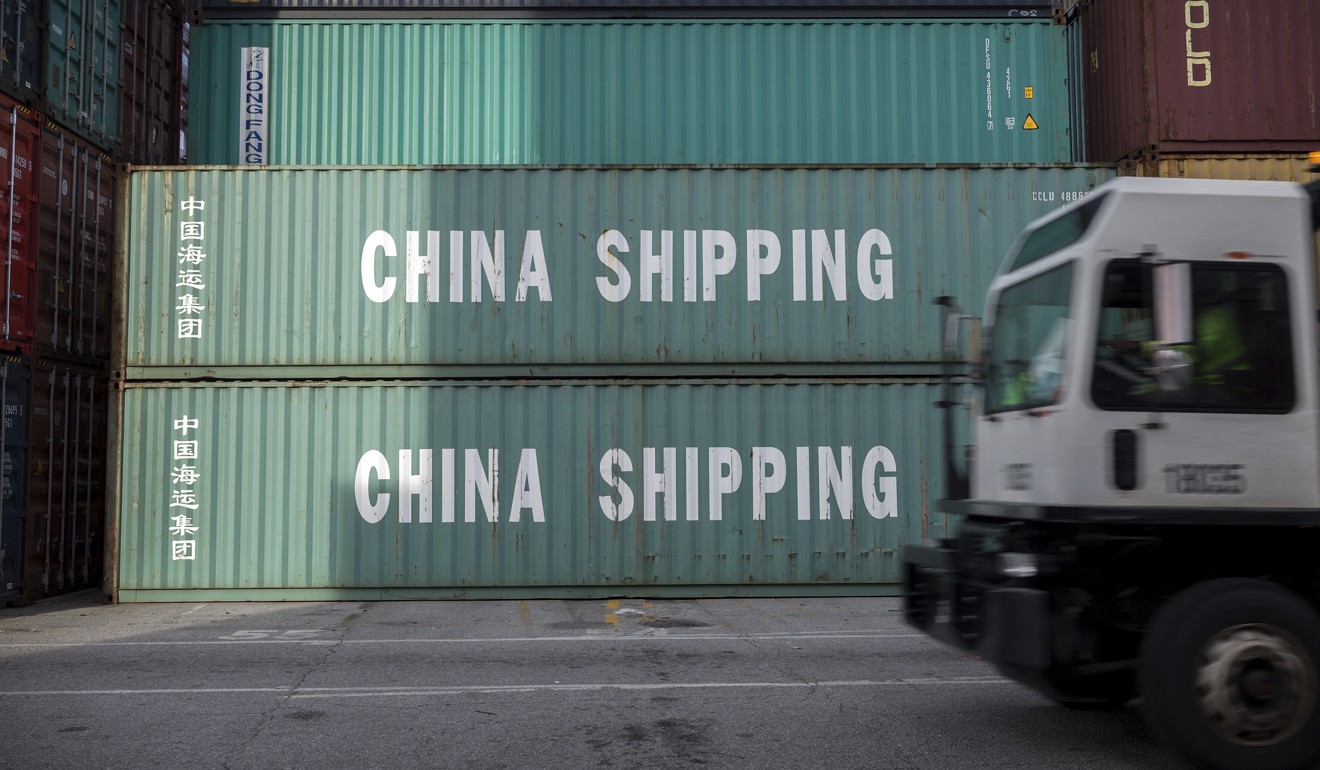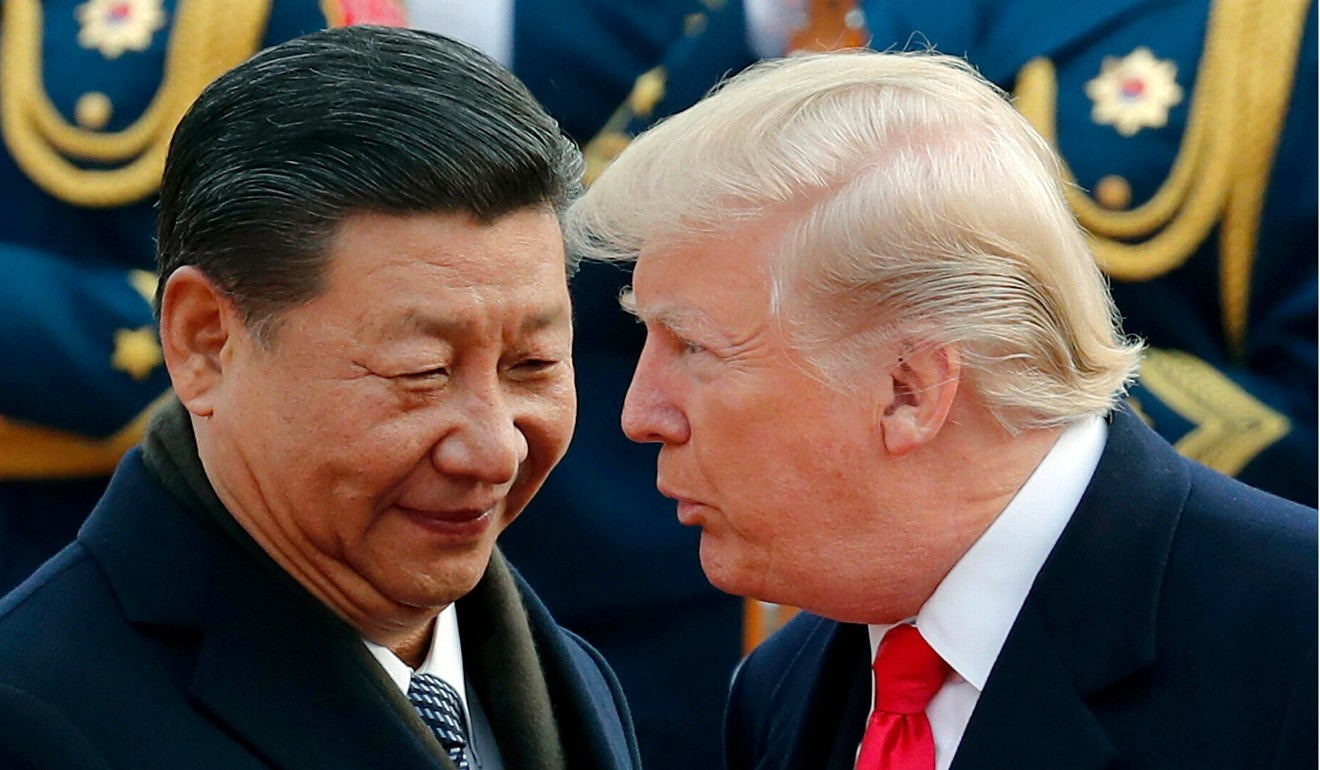Owen Churchill
 Beijing struck back, as expected, with tariffs on US$60 billion worth of American imports, yet there has been no sign that Trump is preparing to make good on his threat, despite a passing remark on Monday that “we could go US$267 billion more”.
Beijing struck back, as expected, with tariffs on US$60 billion worth of American imports, yet there has been no sign that Trump is preparing to make good on his threat, despite a passing remark on Monday that “we could go US$267 billion more”.
The lull in what has otherwise been an incendiary and fast-moving trade war suggests a directional shift in US strategy, analysts said, as the administration weighs other non-tariff options that would avoid domestic resistance ahead of pivotal midterm elections.
These include military action, including sanctions on the Chinese military and an increase in naval exercises around China’s territorial waters; economic sanctions to counter religious suppression; and a rise in anti-China rhetoric, including accusations of Chinese interference in US elections.
Speaking on Thursday about countering what he called China’s “whole-of-government approach” to influencing US affairs, US Vice-President Mike Pence said the United States would “continue to stand strong for our security and our economy”, but did not offer any indication that the administration was preparing to move on tariffs on all Chinese imports.
Voter sentiment ahead of the November 6 midterm elections could be a crucial reason tariffs aren’t being increased further, observers said.
“There’s no question that domestic politics has to be very, very top of mind for the administration in the run-up to the midterm elections,” said Josh Green, co-founder and CEO of Panjiva, a company that provides data on global trade.
Expanding tariffs to cover all Chinese imports could mean price increases for consumer goods including cellphones, apparel and toys, which so far have largely been spared the heavy hand of duties. “It’s not a coincidence that the early tariffs were specifically not product categories where consumers were likely to feel the pain,” Green said.
The unprecedented act of imposing tariffs on all Chinese imports “could weigh on the minds of some trade negotiators”, said Orit Frenkel, who was director for trade in hi-tech products at the Office of the US Trade Representative (USTR) in the 1980s.
Frenkel, who now runs the global consulting firm Frenkel Strategies, did note that Trump’s successful negotiation of the US-Mexico-Canada trade agreement may embolden his faith in the power of tariffs.
“[Trump has] said point blank that tariffs are great, tariffs are successful, tariffs have been useful in reaching an agreement,” she said, referring to his claim that the prospect of tariffs had pressured Canada into accepting the deal.
But so far that has not been the case with Beijing, which has shown no sign of bending to Washington’s will during any of the multiple trade war escalations since tariffs began in early July.
 Allen Carlson, an associate professor of government at Cornell University, said this could be especially frustrating for Trump, “who seems to expect instant reaction and gratification for his actions”. The absence of any radical shift in Beijing’s position in the face of previous rounds of tariffs, he said, would be “particularly grating and emerging as a driver for exploring other policy”.
Allen Carlson, an associate professor of government at Cornell University, said this could be especially frustrating for Trump, “who seems to expect instant reaction and gratification for his actions”. The absence of any radical shift in Beijing’s position in the face of previous rounds of tariffs, he said, would be “particularly grating and emerging as a driver for exploring other policy”.
Messages to the White House, State Department and USTR requesting comment on trade strategy went unanswered.
Speaking on Thursday at the Washington-based Hudson Institute, a conservative think tank, Pence vowed that the US would push back against Chinese aggression of all types, ing that Beijing was using political, economic, military and propaganda tools “in more proactive ways than ever before to exert influence and interfere in the domestic policy and politics of our country.”
“But our message to China’s rulers is this: This president will not back down – and the American people will not be swayed,” Pence said. “We will continue to stand strong for our security and our economy, even as we hope for improved relations with Beijing.”
Washington has shown a recent willingness to go beyond tariffs in favour of other pressure tactics, including the imposition in late September of sanctions on China’s military after a state contractor bought arms from a Russian supplier.
It marked the first time the US had sanctioned any country for doing business with individuals on its blacklist of Russian defence entities, and China quickly retaliated, revoking permission for a US Navy ship’s port call in Hong Kong.
The sanctions were “step one” in the Trump administration’s broader, non-tariff approach to squeezing Beijing, said Derek Scissors, resident scholar at the American Enterprise Institute.
“The Chinese did not see that coming,” said Scissors, who has offered counsel to officials on both sides of the trade dispute. The measures had no economic significance, he said, “but the Chinese found that a major widening of the conflict, and we could get another one like that”.
 Another such escalation could result if the US goes through with a series of sea- and air-based naval exercises in international waters near the South China Sea and Taiwan Strait in November. Citing several US defence officials, CNN reported on Wednesday that the plans were still under consideration, but that they had developed to the stage that they had been given an operational code name.
Another such escalation could result if the US goes through with a series of sea- and air-based naval exercises in international waters near the South China Sea and Taiwan Strait in November. Citing several US defence officials, CNN reported on Wednesday that the plans were still under consideration, but that they had developed to the stage that they had been given an operational code name.
The defence officials acknowledged that the exercises would touch a nerve in Beijing, which protests perfunctorily whenever there is a perceived infringement of its territory.
“The United States Navy will continue to fly, sail and operate wherever international law allows and our national interests demand,” Pence said on Thursday. “We will not be intimidated; we will not stand down.”
The increase in military tension was punctuated recently when US Defence Secretary James Mattis pulled out of a high-profile meeting with Chinese counterparts in Beijing. The move was initially reported to have been prompted by China, but later confirmed by officials from both governments to have been a US decision.
Front and centre in Pence’s speech on Thursday was the commitment to protect the US from Chinese “meddling in America’s democracy”.
“Worst of all,” he said, “China has initiated an unprecedented effort to influence American public opinion, the 2018 elections and the environment leading into the 2020 presidential elections.”
It was a renewal of accusations made by Trump last week, when he said Beijing was targeting US voters when the Communist Party-run China Daily bought an advertising supplement in the Des Moines Register, the largest newspaper in the agricultural state of Iowa, to highlight the impact of tariffs on soybean farmers.
But US Homeland Security Secretary Kirstjen Nielsen, speaking at a cybersecurity event hosted by The Washington Post, dampened those claims on Tuesday when she said there was no evidence that China was seeking to undermine the electoral process.
“We currently have no indication that a foreign adversary intends to disrupt our election infrastructure,” Nielsen said, drawing a distinction between an attack on voting systems and broader influence strategies aimed at swaying voters.
She categorised China’s current strategy as the latter, calling it “a more holistic approach to influence the American public in favour of China”.
The Chinese foreign ministry has repeatedly rejected allegations of election interference.
In response to Pence’s speech, ministry spokeswoman Hua Chunying characterised the vice-president’s remarks as smears of China. “It is purely groundless speculation, confusing fact with fiction and drawn from thin air,” she said on Friday. “China rejects this resolutely.”
There are also signs that the US is considering sanctions against China on humanitarian grounds, amid evidence that hundreds of thousands of Muslims in the country’s far west are being held and subjected to enforced political re-education.
On Thursday, Pence became the highest-ranking US official to publicly condemn the mass internment of Uygurs and other largely Muslim ethnic groups in the Xinjiang region, a sign that a policy decision could be near.
During recent US congressional hearings, witnesses from academia and human rights advocacy appealed to lawmakers to take action against both Chinese officials involved in the crackdown on ethnic Uygurs and US companies found to be supplying China with surveillance and other security technology that may be in use in Xinjiang.
The US Commerce Department, in collaboration with the State Department, could announce changes to export policy in the coming weeks, Commerce Secretary Wilbur Ross told Senator Marco Rubio in a letter obtained by Reuters.
Under consideration are measures tightening restrictions on certain Chinese entities’ ability to procure US technology, as well as updates to the US list of technologies deemed to have applications that could endanger human rights.
Sanctions to punish religious repression would likely garner bipartisan support in Congress, Scissors said. Such action “would be very popular with parts of the Republican Party, and would be hard for parts of the Democratic Party to object to”, he said. “It’s an interesting political move, whatever the substance.”
China’s crackdown on the Uygurs and purchase of the newspaper advertorials “played into the hand” of those in the Trump administration who want to push back against Beijing, Scissors said.
 “You’re soft on people who are religious oppressors? You’re soft on people who have tried to intervene on US domestic politics?”
“You’re soft on people who are religious oppressors? You’re soft on people who have tried to intervene on US domestic politics?”
Yet as the dispute with China spreads beyond just trade, some observers said the American moves were not necessarily evidence of a clear strategy.
“A shift implies that there is a coherent policy in the first place, and this seems to be to a fallacy,” said Carlson, the Cornell professor.
“It is far from clear to me that the Trump administration has such an approach to China, or the rest of the world,” he said.
“On the contrary, policy in this White House seems to be largely driven by the whims of the president, while those around him struggle to make sense of just which way the wind is blowing out of the Oval Office on any given day.”
No comments:
Post a Comment